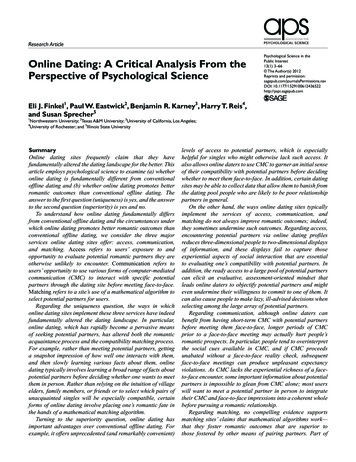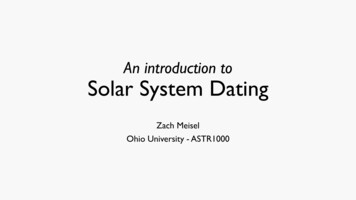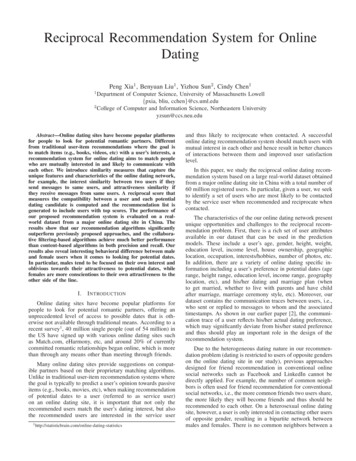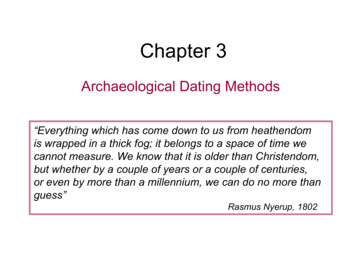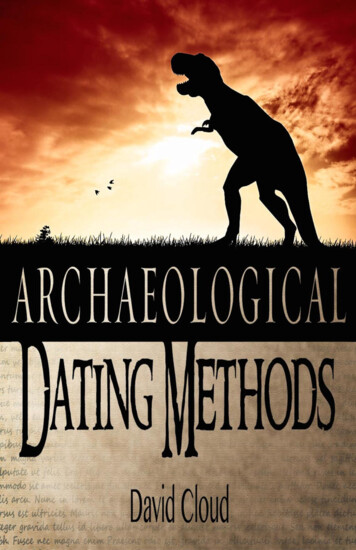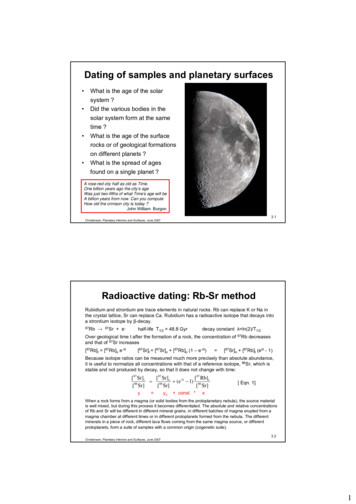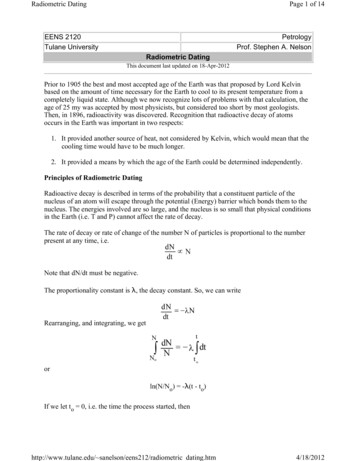
Transcription
Radiometric DatingPage 1 of 14EENS 2120Tulane UniversityPetrologyProf. Stephen A. NelsonRadiometric DatingThis document last updated on 18-Apr-2012Prior to 1905 the best and most accepted age of the Earth was that proposed by Lord Kelvinbased on the amount of time necessary for the Earth to cool to its present temperature from acompletely liquid state. Although we now recognize lots of problems with that calculation, theage of 25 my was accepted by most physicists, but considered too short by most geologists.Then, in 1896, radioactivity was discovered. Recognition that radioactive decay of atomsoccurs in the Earth was important in two respects:1. It provided another source of heat, not considered by Kelvin, which would mean that thecooling time would have to be much longer.2. It provided a means by which the age of the Earth could be determined independently.Principles of Radiometric DatingRadioactive decay is described in terms of the probability that a constituent particle of thenucleus of an atom will escape through the potential (Energy) barrier which bonds them to thenucleus. The energies involved are so large, and the nucleus is so small that physical conditionsin the Earth (i.e. T and P) cannot affect the rate of decay.The rate of decay or rate of change of the number N of particles is proportional to the numberpresent at any time, i.e.Note that dN/dt must be negative.The proportionality constant is λ, the decay constant. So, we can writeRearranging, and integrating, we getorln(N/No) -λ(t - to)If we let to 0, i.e. the time the process started, thenhttp://www.tulane.edu/ sanelson/eens212/radiometric dating.htm4/18/2012
Radiometric DatingPage 2 of 14(1)We next define the half-life, τ1/2, the time necessary for 1/2 of the atoms present to decay.This is where N N0/2.Thus,or-ln 2 -λt,so thatThe half-life is theamount of time it takesfor one half of theinitial amount of theparent, radioactiveisotope, to decay to thedaughter isotope. Thus,if we start out with 1gram of the parentisotope, after thepassage of 1 half-lifethere will be 0.5 gramof the parent isotopeleft.After the passage oftwo half-lives only 0.25gram will remain, andafter 3 half lives only0.125 will remain etc.Knowledge of W1/2 or λ would then allow us to calculate the age of the material if we knew theamount of original isotope and its amount today. This can only be done for 14C, since we knowN0 from the atmospheric ratio, assumed to be constant through time. For other systems we haveto proceed further.http://www.tulane.edu/ sanelson/eens212/radiometric dating.htm4/18/2012
Radiometric DatingPage 3 of 14Some examples of isotope systems used to date geologic materials.ParentDaughterUseful RangeW1/22382064.47 b.y235207707 m.y232208Pb14 b.yAr & 40Ca1.28 b.y 10,000 years48 b.y 10 million yearsUPbUPbTh40K408787Rb147SmSr143Nd1414CNType of Material 10 million yearsIgneous & sometimesmetamorphic rocks andminerals106 b.y.5,730 y100 - 70,000 yearsOrganic MaterialTo see how we actually use this information to date rocks, consider the following:Usually, we know the amount, N, of an isotope present today, and the amount of a daughterelement produced by decay, D*.By definition,D* N0 - Nfrom equation (1)So,D* Neλt-N N(eλt-1)(2)Now we can calculate the age if we know the number of daughter atoms produced by decay,D* and the number of parent atoms now present, N. The only problem is that we only know thenumber of daughter atoms now present, and some of those may have been present prior to thestart of our clock.We can see how do deal with this if we take a particular case. First we'll look at the Rb/Srsystem.The Rb/Sr Systemby β decay. The neutron emits an electron to become a proton.For this decay reaction, λ 1.42 x 10-11 /yr, W1/2 4.8 x 1010 yrat present, 27.85% of natural Rb is 87Rb.http://www.tulane.edu/ sanelson/eens212/radiometric dating.htm4/18/2012
Radiometric DatingPage 4 of 14If we use this system to plug into equation (2), then87Sr* 87Rb (eλt-1)(3)but,87Sr 87Sr 87Sr*t0or87Sr* 87Sr - 87Srt0Plugging this into equation (3)87Sr 87Sr 87Rb (eλt-1)t0(4)We still don't know 87Sr0 , the amount of 87Sr daughter element initially present.To account for this, we first note that there is an isotope of Sr, 86Sr, that is:(1) non-radiogenic (not produced by another radioactive decay process),(2) non-radioactive (does not decay to anything else).Thus, 86Sr is a stable isotope, and the amount of 86Sr does not change through timeIf we divide equation (4) through by the amount of 86Sr, then we get:(5)This is known as the isochron equation.We can measure the present ratios of (87Sr/86Sr)t and (87Rb/86Sr)t with a mass spectrometer,thus these quantities are known.The only unknowns are thus (87Sr/86Sr)0 and t.Note also that equation (5) has the form of a linear equation, i.e.y mx bwhere b, the y intercept, is (87Sr/86Sr)0 and m, the slope is (eλt - 1).How can we use this?http://www.tulane.edu/ sanelson/eens212/radiometric dating.htm4/18/2012
Radiometric DatingPage 5 of 14First note that the time t 0 is thetime when Sr was isotopicallyhomogeneous, i.e. 87Sr/86Sr wasthe same in every mineral in therock (such as at the time ofcrystallization of an igneous rock).In nature, however, each mineral inthe rock is likely to have adifferent amount of 87Rb. So thateach mineral will also have adifferent 87Rb/86Sr ratio at thetime of crystallization. Thus, oncethe rock has cooled to the pointwhere diffusion of elements doesnot occur, the 87Rb in each mineralwill decay to 87Sr, and eachmineral will have a different 87Rband 87Sr after passage of time.We can simplify our isochron equation somewhat by noting that if x is small,so that (eλt - 1) λt, when λt is small.So, applying this simplification,(6)and solving for tThe initial ratio, (87Sr/86Sr)0, is useful as a geochemical tracer. The reason for this is that Rbhas become distributed unequally through the Earth over time.For example the amount of Rb in mantle rocks is generally low, i.e. less than 0.1 ppm. Themantle thus has a low 87Rb/86Sr ratio and would not change its 87Sr/86Sr ratio very much withtime.http://www.tulane.edu/ sanelson/eens212/radiometric dating.htm4/18/2012
Radiometric DatingPage 6 of 14Crustal rocks, on the other hand generally have higher amounts of Rb, usually greater than 20ppm, and thus start out with a relatively high 87Rb/86Sr ratio. Over time, this results in crustalrocks having a much higher 87Sr/86Sr ratio than mantle rocks.Thus if the mantle has a 87Sr/86Sr of say 0.7025, melting of the mantle would produce amagma with a 87Sr/86Sr ratio of 0.7025, and all rocks derived from that mantle would have aninitial 87Sr/86Sr ratio of 0.7025.On the other hand, if the crust with a 87Sr/86Sr of 0.710 melts, then the resulting magma wouldhave a 87Sr/86Sr of 0.710 and rocks derived from that magma would have an initial 87Sr/86Srratio of 0.710.Thus we could tell whether the rock was derived from the mantle or crust be determining itsinitial Sr isotopic ratio as we discussed previously in the section on igneous rocks.The U, Th, Pb SystemTwo isotopes of Uranium and one isotope of Th are radioactive and decay to produce variousisotopes of Pb. The decay schemes are as follows1.by D decayλ238 1.551 x 10-10/yr, W1/2 4.47 x 109 yr2.λ235 9.849 x 10-10/yr, W1/2 0.707 x 109 yrNote that the present ratio of3.λ232 4.948 x 10-11/yr, W1/2 1.4 x 1010 yr232Th has such along half life that it is generally not used in dating.204Pb is a stable non-radiogenic isotope of Pb, so we can write two isochron equations and gettwo independent dates from the U - Pb system.(7) andhttp://www.tulane.edu/ sanelson/eens212/radiometric dating.htm4/18/2012
Radiometric DatingPage 7 of 14(8)If these two independent dates are the same, we say they are concordant.We can also construct a Concordia diagram, which shows the values of Pb isotopes that wouldgive concordant dates. The Concordia curve can be calculated by defining the following:(9)and(10)We can plug in t and solve for the ratios 206Pb*/238U and 207Pb*/235U to define a curve calledthe Concordia.http://www.tulane.edu/ sanelson/eens212/radiometric dating.htm4/18/2012
Radiometric DatingPage 8 of 14The Concordia is particularly useful in dating of the mineral Zircon (ZrSiO4). Zircon has ahigh hardness (7.5) which makes it resistant to mechanical weathering, and it is also veryresistant to chemical weathering. Zircon can also survive metamorphism. Chemically, zirconusually contains high amounts of U and low amounts of Pb, so that large amounts of radiogenicPb are produced. Other minerals that also show these properties, but are less commonly used inradiometric dating are Apatite and sphene.If a zircon crystal originally crystallizes from a magma and remains a closed system (no loss orgain of U or Pb) from the time of crystallization to the present, then the 206Pb*/238U and207Pb*/235U ratios in the zircon will plot on the Concordia and the age of the zircon can bedetermined from its position on the plot.Discordant dates will notfall on the Concordia curve.Sometimes, however,numerous discordant datesfrom the same rock will plotalong a line representing achord on the Concordiadiagram. Such a chord iscalled a discordia.The discordia is often interpreted by extrapolating both ends to intersect the Concordia. Theolder date, t0 is then interpreted to be the date that the system became closed, and the youngerdate, t*, the age of an event (such as metamorphism) that was responsible for Pb leakage. Pbleakage is the most likely cause of discordant dates, since Pb will be occupying a site in thecrystal that has suffered radiation damage as a result of U decay. U would have been stable inthe crystallographic site, but the site is now occupied by by Pb. An event like metamorphismcould heat the crystal to the point where Pb will become mobile.Another possible scenarioinvolves U leakage, againpossibly as a result of ametamorphic event. Uleakage would causediscordant points to plotabove the cocordia. But,again, exptrapolation of thediscordia back to the twopoints where it intersectsthe Concordia, would givetwo ages - t* representingthe possible metamorphicevent and t0 representingthe initial crystallization agehttp://www.tulane.edu/ sanelson/eens212/radiometric dating.htm4/18/2012
Radiometric DatingPage 9 of 14of the zircon.We can also define what are called Pb-Pb Isochrons by combining the two isochron equations(7) and (8).(11)Since we know that the, and assuming that the 206Pb and 207Pb dates are thesame, then equation (11) is the equation for a family of lines that have a slopethat passes through the pointThe Age of the Earth1. A minimum age of the Earth can be obtained from the oldest known rocks on the Earth.So far, the oldest rock found is a tonalitic Gneiss (metamorphic rock) rock from theNorthwest Territories, Canada, with an age of 3.962 Billion 3 million years. This givesus only a minimum age of the Earth. Is it likely that we will find a rock formed on theEarth that will give us the true age of the Earth?http://www.tulane.edu/ sanelson/eens212/radiometric dating.htm4/18/2012
Radiometric DatingPage 10 of 142. An estimate can be obtained from arguments in nuclear physics, which says that the235 238U/ U ratio may have been 1.0 when the elements formed. Thus, sincewe can writeorand solve for t . The answer is about 6 billion years.This argument tells when the elements were formed that make up the Earth, butdoes not really give us the age of the Earth. It does, however, give a maximum ageof the Earth.3. From the Pb-Pb isochron equation (11) we can make some arguments about meteorites.First, it appears that meteorites have come from somewhere in the solar system, and thusmay have been formed at the same time the solar system (and thus the Earth) formed.If all of the meteorites formed at the same time and have been closed to U and Pb sincetheir formation, then we can use the Pb-Pb isochron to date all meteorites. First, however,we need to know the initial ratios of the Pb isotopes.We recognize two major types of meteorites:Fe- meteorites and stony (or chondritic) meteoritesThe Fe meteorites contain the mineral troilite (FeS) that has no U. Since the mineraltroilite contains no U, all of the Pb present in the troilite is the Pb originally present, andnone of it has been produced by U decay. Thus, the troilite in the Fe-meteorites will giveus the initial ratios of 206Pb/204Pb and 207Pb/204Pb.http://www.tulane.edu/ sanelson/eens212/radiometric dating.htm4/18/2012
Radiometric DatingPage 11 of 14We can then determine the Pb ratios in other meteorites and see if they fall on a Pb-Pbisochron that passes through the initial ratios determined from troilite in Fe-meteorites.The slope of this isochron, known as the Geochron, gives an age of 4.55 0.07 x 109 yrs.Is this the age of the Earth?Lunar rocks also lie on the Geochron, at least suggesting that the moon formed atthe same time as meteorites.Modern Oceanic Pb - i.e. Pb separated from continents and thus from average crustalso plots on the Geochron, and thus suggests that the Earth formed at the sametime as the meteorites and moon.Thus, our best estimate of the age of the Earth is 4.55 billion years.Other Dating MethodsSm - Nd Dating147Sm 143Ndλ 6.54 x 10-12 /yr, W1/2 1.06 x 1011 yr144Nd is stable and non-radiogenic, so we can write the isochron equation as:http://www.tulane.edu/ sanelson/eens212/radiometric dating.htm4/18/2012
Radiometric DatingPage 12 of 14The isochron equation is applied just like that for the Rb-Sr system, by determining the143Nd/144Nd and 147Sm/144Nd ratios on several minerals with a mass spectrometer and thenfrom the slope determine the age of the rock.The initial ratio has particular importance for studying the chemical evolution of the Earth'smantle and crust, as we discussed in the section on igneous rocks.K-Ar Dating40K is the radioactive isotope of K, and makes up 0.119
18.04.2012 · system. The Rb/Sr System by βdecay. The neutron emits an electron to become a proton. For this decay reaction, λ 1.42 x 10-11 /yr, W 1/2 4.8 x 10 10 yr at present, 27.85% of natural Rb is 87Rb. Radiometric Dating Page 3 of 14 http://www.tulane.edu/ sanelson/eens212/radiometric_dating.htm 4/18/2012
